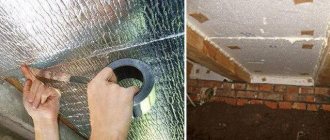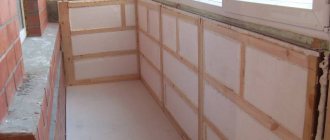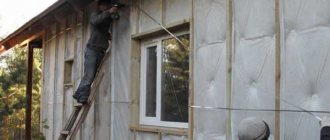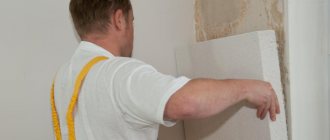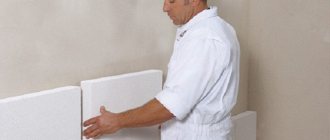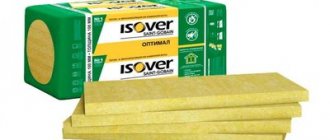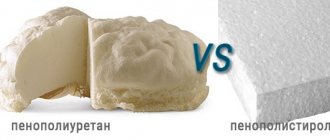To build a comfortable, warm home, it is not enough just to install heating and seal the seams .
With thin walls that do not retain heat well, heating costs will be incredibly high, and the heat in the house will not be retained.
To ensure that warm air does not escape from the room, and that the walls perform not only the function of protection from external influences, but also the function of thermal insulation, it is necessary to insulate them.
The following materials are suitable for insulation:
- mineral wool;
- Styrofoam;
- extruded polystyrene foam;
- penoplex;
- penofol;
- penoizol;
- polyurethane foam.
Insulation of walls inside and outside the house - differences
Wall insulation is carried out both inside and outside .
If it is necessary to insulate walls, then, as a rule, one insulation option is chosen: either from the inside of the load-bearing wall or from the outside.
It is also possible to insulate a wall on both sides, but this is not always necessary : insulation options are chosen based on climatic conditions, construction features, and individual preferences.
Indoor insulation is installed on the inside of the building.
The disadvantages of this option are the following:
- the free space of the room decreases;
- the likelihood of dew point formation inside the wall or between the insulation and the wall.
Internal insulation of the walls of a house is good because:
- weather conditions will not affect the work schedule;
- If the building has cladding, it is possible to preserve it unchanged.
IMPORTANT!
When installing internal insulation, it is necessary to install a reliable vapor barrier inside the building.
Insulation of external walls is carried out from the outside of the building. With this type of thermal insulation, the usable area of the structure is preserved; there is no need to install a vapor barrier layer . However, if the cladding of the building has already been completed, it must be dismantled.
External insulation
Groups of insulation systems for facades
Currently, the following facade insulation systems are used in practice:
- light and heavy “wet” systems, where a polymer board or mineral wool is the insulation, and the base is a plaster mixture. In heavy systems, the layer of plaster reaches fifty millimeters. It is much thicker. Otherwise the systems are similar. Fastening is carried out with fasteners and glue. The finishing can be done with thermal insulation and appropriate coating;
- multilayer structures;
- facades with ventilation.
Pie wall elements
Before insulating the walls of the house and attic, it is necessary to correctly lay the layers of the cake. Pie walls are sequentially laid layers of materials that serve to ensure a comfortable microclimate in the house.
The elements of the wall pie of a wooden house are:
- wooden frame made of timber . Most often made of beams 15x15 cm;
- horizontal wooden lathing , sometimes a metal profile is used;
- insulation made of mineral wool or expanded polystyrene;
- The membrane is multifunctional , performing the function of protection from winds and at the same time acting as a vapor barrier. It is a dense polyethylene film;
- vertical lathing;
- finishing material;
- vapor barrier film;
- internal cladding (plasterboard, lining).
wall pie
For all wooden wall elements, it is necessary to use high-quality wood , which must be dried naturally. In addition, materials should be chosen of high quality and durable so that the walls perform their functions for many years.
External insulation of a frame house. Material selection
A frame house is the most economical type of housing to build. The special frame structure requires insulation work during construction. In fact, insulation is the only protection of a frame structure from the cold. How to insulate a house?
- Expanded polystyrene;
- Mineral wool (basalt slabs);
- Ecowool (cellulose material);
- Other natural materials (peat, sawdust, straw);
- Sprayers.
Note! It is not recommended to insulate frame buildings with polystyrene foam. Frame houses themselves are a fire hazard, so it is better to choose non-flammable, low-flammable insulation.
Requirements for material suitable for insulating a house made of sip panels:
- Environmental friendliness;
- Resistance to fire, moisture accumulation;
- Easy installation on the frame;
- Fire resistance;
- Low thermal conductivity;
- Strength, reliability before destruction.
Types of insulation - which is better?
For proper internal insulation of a wooden house, insulation materials are used that, while maintaining thermal insulation properties, do not cause an unpleasant odor over time, are fireproof and environmentally friendly.
The most common options for internal insulation are:
- mineral basalt wool . It is the most popular material for wall insulation. The features of this material are: good thermal insulation properties, high level of sound insulation, fire resistance, strength, high hygroscopicity, due to which it is necessary to install piping from vapor barrier films;
- foam boards . Because the material can release styrene, extruded polystyrene foam is used, which requires a containment system. The material has good thermal insulation, has soundproofing properties, however, it is quite fragile;
- glass wool It has greater thermal conductivity than mineral wool, but the price of the material is significantly lower than basalt slabs. The material crumbles a lot, so it should be laid in protective equipment: crumbs of material are harmful to health. In addition, it is necessary to install enclosing structures;
- isoplat . Insulation, which consists of compressed flax fibers and wood board. An ideal thermal insulation material from the point of view of environmental friendliness, and also durable enough that it does not require the installation of fencing systems;
- polyurethane foam , which is installed by spraying it onto the surface, is installed using special equipment. Modern and quite expensive material.
Comparative characteristics of thermal insulation
The type of insulation should be chosen based on the characteristics of the building, climatic conditions, and the purpose of the building.
Thermal insulation
Mineral wool takes the leading position among insulation materials. The material meets all the above criteria and has an affordable price. It goes on sale in the form of rigid slabs or tape rolled into a roll. Polystyrene and its analogues are in slightly less demand. Among the new products, ecowool is in demand.
Mineral wool
Essentially, mineral wool is represented by many fibers that are connected to each other with a special glue. Manufacturers use rocks and volcanic rocks, glass (quartz) or waste from a blast furnace (slag) as raw materials.
The binder may contain a small amount of formaldehyde, but based on laboratory tests, the levels are below acceptable standards. Therefore, the material is considered safe for the health of people and animals living in the house.
The table provides a comparative analysis of the basic characteristics of each type of mineral wool.
| Criterion | Glass wool | Slag | Stone wool | Basalt wool |
| Fiber length/thickness in mm/µm | 50/15 | 46/4-12 | 16/12 | 5/7 |
| Water absorption in %/day | 1,7 | 1,9 | 0,095 | 0,35-0,42 |
| Thermal conductivity coefficient in W/m*K | 0,03-,052 | 0,42-0,48 | 0,077-0,12 | 0,9-0,99 |
| Sound absorption coefficient | 0,8-0,92 | 0,75-0,82 | 0,75-0,95 | up to 1 |
| Operating temperatures in degrees Celsius | -60-+450 | -50-+300 | -150-+600 | -190-+1000 |
| Density in kg/cub.m | 11-220 | 15-250 | 25-215 | 35-165 |
Mineral wool is perfect for internal insulation of walls and roofs of a private house
If you compare materials according to additional criteria, then it is worth highlighting several points. Basalt wool is made with virtually no binder component, lasts about 90 years, does not attract rodents and is superior to analogues in strength.
Stone fiber slabs are on par with their volcanic counterpart. Insulation materials are distinguished by high density, minimal shrinkage, low water absorption and good vapor permeability. But additional protection from rodents is required and the cost is noticeably higher compared to glass and slag alternatives.
Glass wool lasts the shortest - about 25-30 years. It is distinguished by the fragility of thin and long fibers, which can negatively affect the well-being of the worker. Also, the presence of a large volume of air in the canvas causes inevitable shrinkage of the insulation over time. But mice and rats do not touch it and a cubic meter of material weighs up to 30 kg.
Glass-based insulation materials have excellent noise insulation and thermal insulation properties
Slag wool has another significant drawback - with high humidity, it can become a haven for fungus, mold and bacteria. Rodents love to live in it. It is also worth paying attention to the content of residual acids. Because of them, corrosion may develop on adjacent metal products. But the material is generally environmentally friendly and lasts for more than 30 years.
Styrofoam
For home insulation, polystyrene materials are popular in two versions: foamed and extruded polystyrene foam. This is a synthetic insulator of the budget category, which is available in the form of slabs of different thicknesses. A comparative analysis of basic characteristics is presented in the table below.
| Criterion | Styrofoam | Expanded polystyrene |
| Water absorption in %/28 days | 4 | 0,4 |
| Thermal conductivity coefficient in W/m*K | 0,036-0,5 | 0,028-0,032 |
| Flammability class | G3-G4 | G4 |
| Operating temperatures in degrees Celsius | -50-+70 | -40-+75 |
| Density in kg/cub.m | 15-35 | 28-45 |
| Service life in years | 25-35 | 40-50 |
In fact, each of the options is acceptable for insulating a house, but experts do not recommend it for indoor use due to its synthetic nature. On the other hand, the release of toxins begins only when the plates are heated to + 30 degrees Celsius.
Foam plastic - suitable for both basic and additional thermal insulation of the walls of a house from the inside
Another reason for refusing styrene insulation is the vapor permeability is close to zero (up to 0.018 mg/m*s*Pa). But the undoubted advantage of low water absorption makes us think again. After all, materials exhibit inertness to biological and chemical activity (except for organic compounds).
As a result, the decision remains with each home owner individually. On the one hand, the insulation is lightweight, with low thermal conductivity and resistance to moisture. On the other hand, it does not breathe, is flammable, releases a small amount of toxins when heated and attracts rodents.
Ecowool
Today, the main competitor to traditional materials is the relatively new ecowool. This material is completely environmentally friendly, as it is made from products of the pulp industry (waste, rejects, waste paper). An antiseptic (boric acid) and a fire retardant to reduce flammability (sodium tetraborate) are also added to the composition. It goes on sale in crumbly form.
| Technical indicators of ecowool | |
| coefficient of thermal conductivity | 0.04 W/m*K |
| water absorption coefficient | 20 % |
| density | low |
| vapor permeability | high |
| flammability class | G2 |
Despite the fact that ecowool appeared on the building materials market relatively recently, it has managed to gain great popularity
The service life of ecowool reaches 50 years. It is lightweight and safe. The material is suitable for recycling after dismantling. But there are noticeable shortcomings. The main thing is large shrinkage - up to 20%. For comparison, for mineral wool the indicator reaches 1% for dense samples, up to 5% for soft ones. Due to this shrinkage, ecowool is unacceptable for thermal insulation of floors. To form the most dense coating, special equipment is required. It is quite expensive for a one-time job, so you have to hire professionals. It is not recommended to do the work yourself.
Polyurethane foam
Another material from the category of new products occupying a leading position. This is a synthetic material that is sold in the form of canvas, board or foam. The structure of the material is cellular, so the insulation is characterized by low weight (air makes up up to 90% of the total volume).
Pros and cons of polyurethane foam
- The main advantage of polyurethane foam is its low thermal conductivity (0.019-0.035 W/m*K. That is, compared to analogues, to achieve identical efficiency, a layer of thinner thickness will be required. Also, there will be no load on the load-bearing structures.
- However, there are some disadvantages to consider. To insulate a home, a foam-like product is most often used. Its consumption is relatively high. There will be no cold bridges here, the breathability is good, but additional protection of the insulator from moisture is required. The material belongs to the group of expensive ones; special equipment is needed to work with walls and ceilings. The disadvantages also include a relatively short service life - 20-25 years.
Liquid polyurethane foam is applied to walls by spraying
Seal cracks in walls and insulate
In wooden beams dried using the appropriate technology, cracks form that need to be sealed.
Means for sealing cracks are:
- sealants and other synthetic products : resins, mastics, mounting foams. Synthetic sealants should not have an acrylic substance. Silicone seals must have a high level of frost resistance. The mixtures are placed deeply into the gap, and after drying the area is leveled. Polyurethane foam is used in places where facing work will subsequently be carried out;
- wood shavings mixed with wood glue . Used at any stage of finishing, as well as during additional inspection. The prepared mixture is poured into the previously cleaned crack of dust, then, after complete drying, the area is processed by grinding. The method is advisable to use for small cracks;
- decorative mixtures for sealing;
- fibrous materials - caulk (moss, wool, tow). Pre-cleaned cracks, impregnated with antiseptics and solutions that prevent the formation of mold, mildew, and dampness, are clogged with caulk.
NOTE!
Insulation at the joints of timber is done with sealants, mixtures or adhesive shavings . If the wall is made of logs, then the joints should be sealed only with fibrous materials.
Wood requires constant care and timely sealing of cracks that may appear over time. Regular inspection of the wood will help prevent gaps from growing, which can reduce the insulation properties of the walls.
Sealing tow
Sealing with sealant
Basalt wool
One of the varieties of mineral wool. It contains rocks, it can also be basalt, which is where the name comes from. In terms of thermal conductivity it is inferior to foam plastic, but cotton wool does not burn and is considered a breathable material.
Suitable for any building, can also serve as a noise absorber. The big advantage is that this species is not interesting for rodents, so there is no fear that the insulation may gradually disappear due to the destruction of pests.
- This type of material must be well fixed, because during operation if it is not securely fastened, it can go down.
- Basalt wool is not very strong, so it will begin to deteriorate over time.
- Another disadvantage is melting at high temperatures.
You should also protect the material from moisture, otherwise it will begin to deteriorate even faster from this factor.
Preparing the sheathing and installing it
For the sheathing of walls inside a wooden dacha, wooden materials are used. Metal lathing is installed when the wall is covered with moisture-resistant plasterboard.
The installation of sheathing includes a number of preparatory works in the following order:
- apply markings for installation of the sheathing. The width of the sheathing is selected based on the width of the insulation minus 2-5 millimeters . The insulation should stand up against the sheathing;
- preparation of corner posts . Necessary for creating an even wall angle. The height of the beam 50x100 mm should be equal to the height of the room. The smaller beam 50x50 mm is fastened with self-tapping screws to the edge of the larger beam, forming a right angle;
- making corner posts for all corners of the room;
- preparation of vertical boards for sheathing: boards are cut according to the height of the room in quantities corresponding to the pitch, 2 - 5 cm less than the insulation board.
Installation of the sheathing begins from the corners : using self-tapping screws, the corner posts are installed in their places, their vertical position is checked with a level. Next, from the corners to the center, the remaining sheathing boards are attached along the entire perimeter.
The next step is to install strips around the wall openings.
CAREFULLY!
All wooden elements of the sheathing must be treated with solutions against mold, mildew, and moisture.
After installing the lathing, a layer of heat-insulating material is laid.
Installation of sheathing
Insulation of facade under plaster
Quite often in practice, plaster is used to insulate facades. It's convenient and profitable. “Wet facade” is a method in which the insulation board must be attached to the wall. Then a layer of plaster is placed on top.
The kit for insulation and finishing does not always include insulation boards. Therefore, they are selected separately. They can be mineral wool or polymer.
The cotton insulation is durable and does not burn. However, compared to polystyrene foam, it is heavier and absorbs moisture better. They can be treated with a special compound, but it is better to use two-layer slabs with a denser top layer.
The softness of the bottom layer allows the material to adhere more tightly to the walls. For such insulation, you need a plaster composition with good vapor permeability.
Vapor barrier and waterproofing of walls
When insulating walls internally, it is necessary to install a vapor barrier and waterproofing layer.
Vapor barrier materials can be:
- polypropylene films;
- foamed polymer films;
- foil films;
- diffusion membranes.
The vapor barrier layer is produced taking into account the specifics of its installation:
- The film should be attached to the sheathing using an overlapping stapler, and the joining points should be taped;
- the lathing on which the vapor barrier is attached should be no more than 5 cm;
- The vapor barrier layer is laid using a continuous contour method around the entire perimeter.
Installation of vapor barrier
A waterproofing layer, which protects against moisture coming from outside, is laid on the wall. Laying nuances:
- the waterproofing film is attached to the sheathing, leaving space for ventilation;
- a profile is attached to the film;
- Insulation is laid between the profile, and then a vapor barrier layer.
Wall waterproofing
The most popular waterproofing material is roofing felt. Vapor barriers and waterproofing must be installed to prevent condensation and ensure dryness of the wall pie. Now let's look at ways to insulate walls from the inside.
Bulk materials
As a rule, such materials are environmentally friendly and inexpensive. Especially in forest regions where there is a lot of sawdust. Bulk insulation is convenient because it is very easy to use.
- For example, to insulate the roof from the attic side, it is enough to simply pour a certain thickness of sawdust or vermiculite and cover it with a waterproofing film. You don't even have to cover it with film.
- The bulk material absorbs and allows moisture to pass through well. Rodents don’t like them, which is also a big plus; they won’t make holes in it.
True, this type of material also has its disadvantages: expanded clay is heavy, so it is not suitable for a light foundation. But vermiculite is also not very light, and it does not absorb moisture.
Insulation of walls from the inside in a private house using mineral wool
Before insulating the walls from the inside, it is necessary to secure the sheathing.
Mineral wool is a material that has good thermal insulation properties, is easy to install and durable.
It is necessary to lay mineral wool slabs between the sheathing boards in such a way that no gaps are formed.
Besides:
- mineral wool is secured with nails and dowels (fungi);
- lay the material from bottom to top;
- The edges of the mineral wool are slightly pressed for a tighter fit.
IMPORTANT!
Mineral wool should be laid in an even layer : without creases and waves; if the installation is multi-layered, the joints should not overlap or form cracks.
After the insulation is securely fastened, a vapor barrier layer is laid on it.
Insulation with mineral wool
Ceiling
Heat loss from the ceiling in cold weather is about 10 percent. Not much, but noticeable. When choosing materials, it is worth choosing environmentally friendly materials that, in the event of a fire, would not emit choking smoke.
Recommended materials are ecowool, mineral wool, different types of films. All of them are not expensive, but are highly effective.
Do-it-yourself insulation of walls from the inside using polystyrene foam
The installation technique with polystyrene foam is quite simple, and if done correctly, it can provide reliable thermal insulation in the house.
Insulation with expanded polystyrene occurs in several stages:
- if the walls are made of round logs, then they need to be trimmed;
- between the lathing slats, panels of material are placed in a tight fit;
- the slabs can be additionally secured with foam blades;
- eliminate possible gaps using polyurethane foam.
Next, a vapor barrier is attached to the sheathing slats.
Insulation with polystyrene foam
Styrofoam
Polystyrene foam has poor vapor permeability, so it is not advisable to use it for wooden buildings.
To avoid the greenhouse effect, you need to consider ventilation.
The material also has its advantages:
- It is lightweight and easy to install;
- Safe, easy to cut;
- It is inexpensive and lasts a long time;
- No rotting, does not lose its shape.
Polystyrene foam is placed in slabs on a flat surface. You don’t have to prepare the screed, the main thing is that the elements do not protrude. The material is simple in that it can simply be glued without further fastening. True, some still attach it with self-tapping screws for reliability.
The joints of the plates must be sealed with polyurethane foam, the excess parts are cut off. Bare and loose parts also need to be sealed.
Insulation with polyurethane foam
Modern thermal insulation polyurethane foam is very well suited for insulating a wooden house from the inside, however, it requires compliance with certain requirements.
First of all, it is necessary to clean the walls from dust and sawdust, protect the floor, windows and doors with protective materials.
Next, carry out a series of works step by step:
- perform sheathing in 60 cm increments with 4x4 cm or 5x5 cm timber;
- spray polyurethane foam between the sheathing boards;
- wait up to 12 hours until the layer of material dries completely;
- level the excess material in accordance with the level of the sheathing.
Next, lay the layers of the wall pie in accordance with the installation technology.
Insulation using polyurethane foam
Thus, insulation inside can be done quite effectively. If you carry out all the stages of laying cake materials using proven technology, you can achieve a good result: the walls will retain heat well in the room and thereby create a favorable indoor microclimate on cold days.
Foundation, floors
Insulation of the foundation of the house itself serves as the basis for thermal protection of your home. Foundation insulation with expanded clay is significantly outdated; today the most effective and economical method is insulation with polymer materials. Let's consider the option of polystyrene foam insulation.
Calculate materials. Take a careful measurement of the foundation, consider possible options for covering it and choose the optimal one. This will help reduce costs on materials.
Next, cover the foundation layers with material. It is difficult to give general advice, since foundation designs may differ. The insulating material should fit tightly to the structure and not leave air pockets.
Use pre-cutting when laying out polystyrene foam boards. Make sure that the surface created by the slabs is level using a level.
In the photo, insulating a house with polystyrene foam boards with your own hands looks difficult, but in reality there should not be any difficulties, unlike, for example, laying out ceramic tiles.
Next, a layer of insulation, a concrete covering, and a finishing floor covering are laid.
This multi-layer insulation scheme will protect the building even from extreme cold.
- News site
- Features of electrical wiring installation in houses made of SIP panels
- How to choose a cast iron bath
Insulation of the facade with mineral wool
The technology of insulating facades with mineral-based wool does not require special skills or complex tools. You can do it yourself, taking advantage of your free time on weekends or in the evening with convenient breaks.
This work is carried out even at sub-zero temperatures, at any time of the year. There is no need to apply glue or solution. There is no need to level the surface of the walls and strengthen it.
Experts recommend using this technology in relation to old buildings with damaged facades. Such work is practically not affected by settlement or deformation of the wall. Moisture in the house does not stay, but evaporates. Mineral wool is universal for walls made of different materials:
- wood concrete;
- wood;
- with frame, etc.
Free access provides the ability to control and replace if necessary.
How to insulate a house outside with mineral wool
Many people use mineral wool for thermal insulation. This type of insulation is suitable for a house whose walls are built of blocks, brick or wood. To ensure that the fastening of the insulation is high-quality and reliable, a frame made of slats is used. The spacer technique is also used here, i.e. the distance between the lathing slats should be slightly less than the width of the mineral wool slab. This can ensure that the insulation fits tightly between the frame posts.
If you are insulating a log house from the outside, the walls of which have an uneven surface, use two-layer mineral wool slabs with different layer densities.
Loose layers of insulation provide high-quality adhesion to the uneven surface of the logs. To provide wind and water protection when insulating walls with mineral wool, you can use polyethylene film. Decorative brickwork, siding and other materials are used as facing materials. Mineral wool slabs are very easy to install
